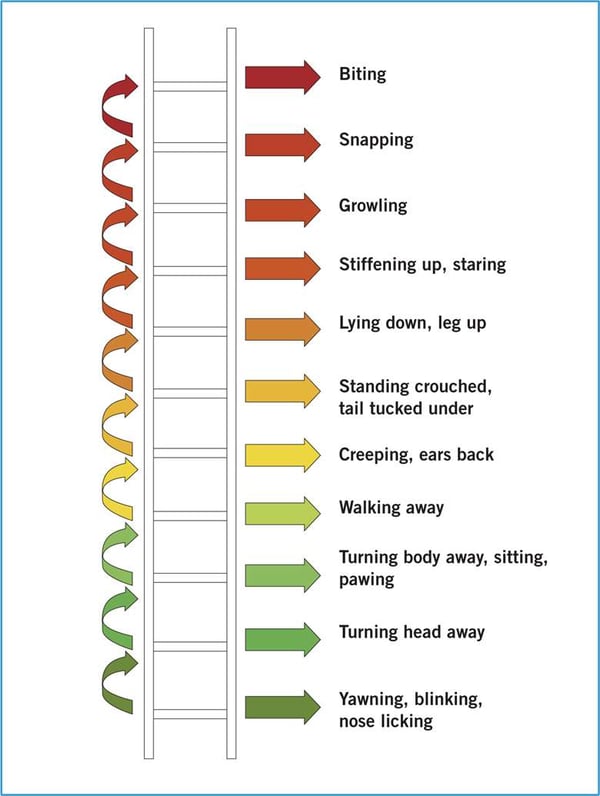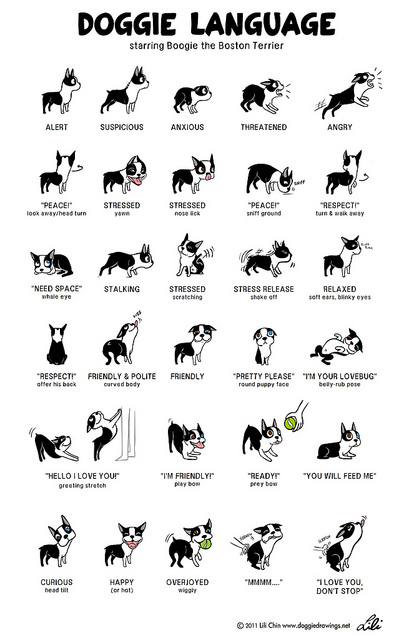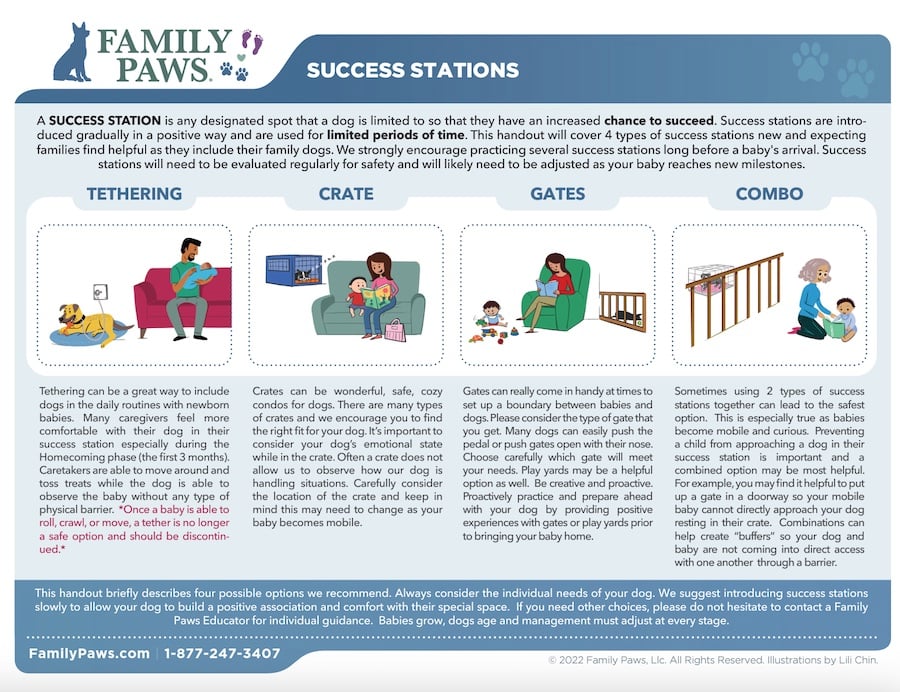 Growing up with a dog has many benefits for children. Trust me, my family always had at least one dog when I was growing up. And my love of dogs as a child grew into an incredible career working with them every day.
Growing up with a dog has many benefits for children. Trust me, my family always had at least one dog when I was growing up. And my love of dogs as a child grew into an incredible career working with them every day.
Studies have shown that children who have dogs have a greater sense of empathy, better social skills, and a lower risk of allergies. Having a pet can be incredibly helpful for children with autism or neurodivergence.
However, there are risks of having a dog around children, both for the child and the dog, simply because dogs have teeth and humans and dogs communicate differently. We expect a lot from dogs — often expecting them to just deal with situations that they don't like without showing their discomfort through dog-appropriate signals like growling or snapping.
When I was growing up, my first dog companion was a little Chihuahua mix that came into our family as a stray. I would dress her up in outfits to enter her in the local pet store's photo competition, cuddle her when she didn't want to be cuddled, and stick my face in her face to give her kisses. All of these things she did not truly appreciate. And she definitely hated my sticking my face in her face, showing her displeasure by biting me a couple of times in warning.
But this was in the early 1990s, and my parents were quite aware that it was my behavior causing the bites in the first place. Plus, she was a Chihuahua, so even if the bites had been worse than they were (they were rather low-level warning snaps), the damage she could do was much less than if it had been our family Rottweiler biting me in the face. My mom's response was, "Stop putting your face in her face." And that was that. I learned.
But the culture of what we expect dogs to put up with has changed since then, and while not necessarily "bad," we often tend to ignore the fact that we humans set up our dogs to fail when it comes to their interactions with children. And when a dog bite to a child happens, I tend to get calls asking about how to rehome their dog or whether behavioral euthanasia is warranted. No one wants to be in that situation. And it's heartbreaking because it's almost always preventable.
Awareness and vigilance on your part — whether you’re a parent, aunt, uncle, grandparent, or just a friend to someone with kids — can go a long way. Staying aware can help prevent problems and ensure that kids reap the benefits of living with a dog. Setting up your home environment to promote boundaries and teaching your children some basics about interacting with dogs safely will help prevent dog bites.
Here are some crucial lessons that all children should be taught about living with or interacting with dogs.
Table of Contents
Teach Your Child to Respect the Dog
It’s important that children learn from an early age to respect dogs. Dogs need their own space, comfort, and ability to make their own decisions as living beings. Respect includes learning to not pull on tails, ears, legs, or fur, and not poking at a dog’s eyes or mouth. It also involves not hugging excessively, pushing, or leaning down on the dog. Respect definitely means no jumping or riding on the dog.
Never let your child handle your dog roughly or in any way that your dog doesn't like. This is asking to be bitten.
The simple rule of respect won’t just serve your children as they grow and bond with your family dog. It will also help your children as they meet and interact with other dogs and other people, too.
It’s not just your child who benefits either. Respect will also serve your dog well by minimizing the stress and anxiety (and potential pain or injury) many dogs experience living with young children. This is an important lesson all around, so please don’t overlook teaching it to your children. Make sure that all adults model respect toward dogs, too.
How to Do a Consent Test with Your Dog
A great way to see if your dog is enjoying the interaction is to do a consent test. These are pretty simple and a great thing to do with your dog at home but also with dogs you or your children meet while out and about.
1. Invite the dog to come to you for petting. If they don't approach, leave them alone.
2. If they do come to you, gently pet on their shoulder, chest, or rear for 1-2-3 seconds. Then stop petting and see what they do.
3. If the dog moves away or doesn't obviously ask for more petting, then don't continue petting. If they lean into you, look up at you, move closer, or obviously ask for more interaction, offer more gentle petting.
4. Throughout your petting, frequently do a consent test – stop petting to see what the dog does. Do they move away? That means they were done. Do they nudge your hand for more? That means they were enjoying it!
Check out this video to see an example of consent tests:
Manage Space
Be sure to take a little bit of time to designate and get your dog comfortable in a “safe place.” A safe space can be a room or area within the home where the dog can easily go when stressed. Make sure that all members of the household know not to disturb the dog when they are in their safe space.
Learn how to set up your dog's safe space here.
Even once the lessons of respecting a dog's space have been taught, it’s imperative that you, as a parent, remember this and never leave your young children unobserved around any dog – including the family dog. Active and proactive supervision is a must. When you can't be actively supervising, then put the dog in a separate space from your child, such as in another room behind a gate, in their crate (if they are happily crate trained), or in their safe space. I'm a big fan of how Family Paws, a training organization specifically focused on helping children and dogs live together safely, recommends "success stations":
Many safety issues arise around resources, such as when a child approaches a dog when they are chewing on a toy or eating their food. It's best to simply separate your dog from your children when they are eating meals or have a chew or toy they value. Use a crate or safe space for these instances. Never let your children grab at the dog's toys, and teach them how to stay at a distance when your dog is enjoying their things or eating their meals.
If your dog has exhibited resource guarding, learn what to do about it in this article.
All Dogs Can Bite
Regardless of a dog’s size or breed, or even typical personality, all dogs can bite. This is a truly important concept for children to know and learn from an early age. Preventing dog bites goes far beyond teaching your kids how to approach and interact with strange dogs (e.g., not running up to them, always asking the dog’s owner if they may say “hi” to the dog, etc.). It must start with how to behave around and interact with their own dog. The majority of dog bites to children each year are from the family dog or the dog of family members or close friends.
I've met many people who claim, "My dog would never..." I work with aggression cases, and many people used to believe the same thing about their dog, only to find themselves dealing with a bite incident. Dogs are not machines. They, just like us, have complex emotions and internal experiences that affect their behavior.
A dog who used to enjoy interacting with children may no longer find it comfortable or fun as they age. Pain or illness can play a huge factor in bite incidents with children, and dogs are quite good at hiding pain ... until that moment when a child leans on them and causes such intense pain that their instinctual response is to lash out with a bite to make it stop. Dogs who are startled are more likely to bite, such as if they are suddenly woken up from sleeping to find a child right up next to them.
There are many reasons a dog may bite, so you and your children should both always be aware that it is a possibility and adjust your interactions accordingly.
Learn to Read Dog Body Language
Very few, if any, dogs bite “out of the blue.” Most only do so after provocation, when they are in pain, or when feeling threatened. Pretty much all dogs give off certain warning signs before they bite. These warning signs are part of the canine communication system — or dog body language — that all children and adults should learn to recognize.
It’s particularly important to teach your children that a dog who is trying to get away from them, or one who is showing teeth or growling, is a dog who is showing the warning signs that they are uncomfortable or unhappy with what your child is doing. A dog displaying these signs may progress to biting if the child doesn’t back off and change the situation. Always listen to the dog!
As a parent, it’s imperative that you recognize and appreciate these signs too. Know that an “air snap” is an important warning sign — it’s often the last warning sign before a bite. A dog who snaps at your child after progressing through those other warning signs, without a change in the situation on your part or your child’s, is doing a good thing — the snap is another warning. An air snap is much more desirable than a bite.
We call this progression of warning behaviors the "Ladder of Aggression." Here's a great visual of the ladder, courtesy of The Veterinary Nurse:

Ideally, you and your child would never let a situation escalate to the point of a growl or air snap, but if it does, immediately remove your child from the situation. Do not reprimand your dog for exhibiting these warning signals. Think of a snap as the last courtesy. If you discourage or punish your dog for these warnings, your dog will learn just to skip those steps and go straight for a bite. That would be a situation in which everybody loses.
Never punish a growl! This can lead to "bites out of no where" because the dog has learned that early and appropriate warning signs are ignored or receive punishment.
Check out this great Doggie Language poster by Lily Chin, which can help you teach your children many of the common ways that dogs may “speak” to them:
 Lili Chin also published a fantastic book about dog body language that is perfect for children (and adults!) called Doggie Language: A Dog Lover's Guide to Understanding Your Best Friend.
Lili Chin also published a fantastic book about dog body language that is perfect for children (and adults!) called Doggie Language: A Dog Lover's Guide to Understanding Your Best Friend.
Check out our Dog Body Language Page for more communication tips and resources.
By teaching children these basics of interacting with dogs, we can help prevent dog bites and ensure a safe and happy relationship between children and dogs. Remember, dogs are wonderful companions, but they are also animals with their own needs and instincts. By respecting their space and communicating with them in a way they understand, you can build a trusting relationship that your child will cherish for the rest of their lives.
If you need help with managing dog-child interactions in your home or are expecting a baby, it's important to connect with a certified professional trainer or behavior consultant as soon as possible.





